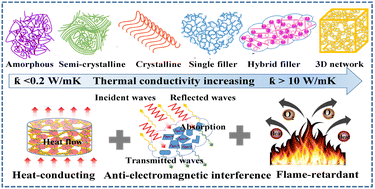Thermally conductive polymer-based composites: fundamentals, progress and flame retardancy/anti-electromagnetic interference design
Abstract
Polymer-based electronic packaging materials (such as epoxy resin, polydimethylsiloxane, and polyvinyl alcohol) are widely used in chips because they have the merits of light weight, corrosion resistance, electrical insulation and ease of processing. With the rapid improvement in the integration and power density of chips in the past decade, electronic packaging materials are required to have excellent thermal conductivity, flame retardancy and anti-electromagnetic interference compatibility (e.g., electromagnetic wave shielding and absorption). Unfortunately, most polymers have low thermal conductivity and are highly electromagnetic wave-transmittable and flammable. Thus, the development of polymer-based electronic packaging materials with high thermal conductivity, flame retardancy and anti-electromagnetic interference performance are highly desirable for next generation electronic devices. In this perspective, we presented the heat conduction mechanism of polymer-based composites and the emerging approaches to enhance the thermal conductivity of polymer-based composites (such as constructing 3D thermally conductive networks). In addition, we also summarized the mechanism and recent progress in anti-electromagnetic interference and flame retardancy studies for these highly thermally conductive polymer-based composites, including compositing carbon materials with ceramics to achieve heat conduction and anti-electromagnetic interference or modifying ceramics with nitrogen and phosphorus compounds to improve heat conductivity and flame retardancy.

- This article is part of the themed collection: Journal of Materials Chemistry C Recent Review Articles


 Please wait while we load your content...
Please wait while we load your content...